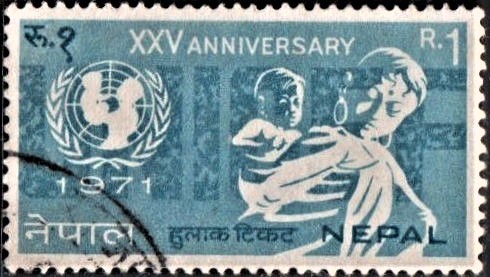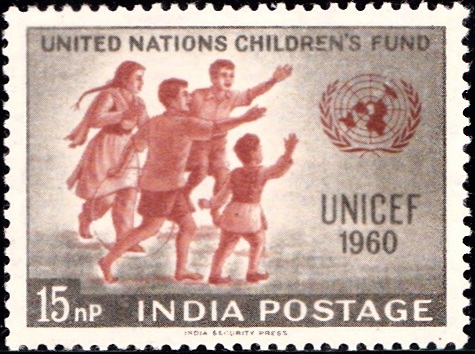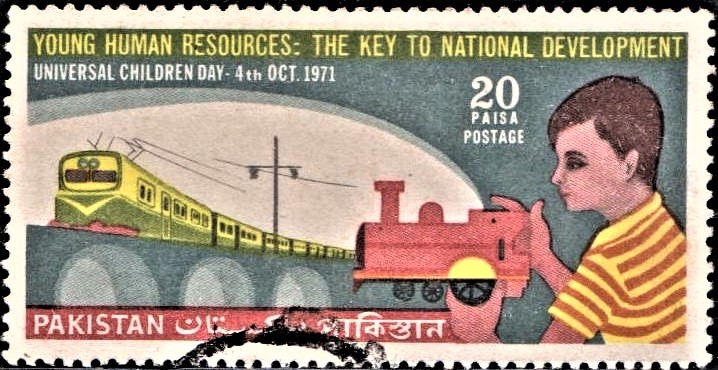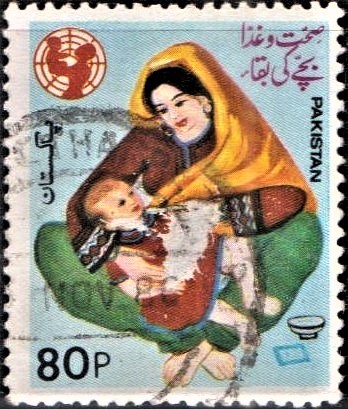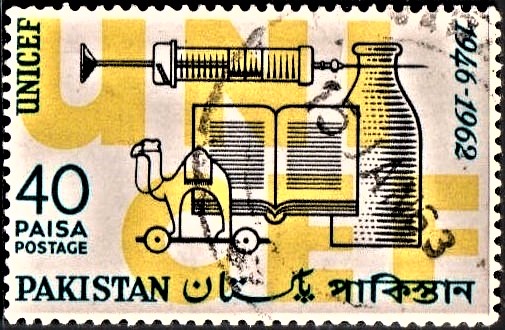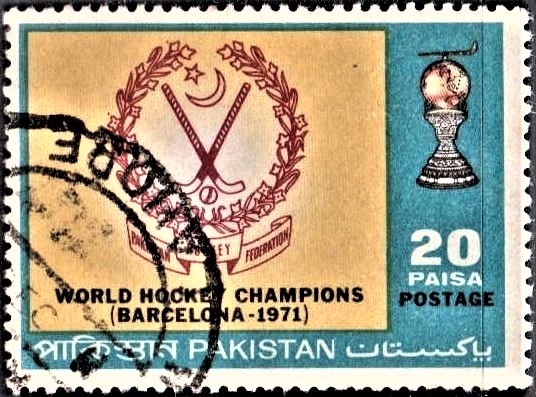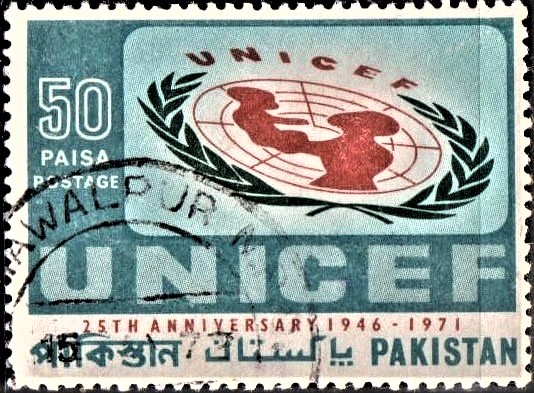
Pakistan on UNICEF 1971
A commemorative postage stamp on the 25th Anniversary of the United Nations Children’s Fund (UNICEF) :
 Issued by Pakistan
Issued by Pakistan
Issued on Dec 11, 1971
Issued for : To commemorate the 25th Anniversary of UNICEF, the Pakistan Post Office is issuing a postage stamp of 50-Paisa denomination on 11th December, 1971.
Design : The format of the stamp is horizontal, the layout consists of the symbol of UNICEF forming the subject of the design, against a turquoise background surrounded by a dark blue border. This border is broad on the left and the bottom sides. Lines indicating the world, the mother holding the child, as well as the letters ‘UNICEF’ and the fiction “25th Anniversary 1946-1971″ are in red colour. The olive branches are in green colour. The value “50” and the words “Paisa” and “Postage” are in reverse, the letters UNICEF are in light blue against the dark blue panel on the left and the bottom. The words ‘Pakistan‘ in Bengali, Urdu and English are also dark blue and lie below the main design, against a white background.
Type : Stamp, Postal Used
Denomination : 50 Paisa
Colour : Vermillion Red, Hookers green, Turquoise and dark blue
Size of stamp : 44.5 x 32.5 m.m.
Size of Print : 41.5 mm x 29.5 m.m.
Perforation gauge : 13 x 13 (c)
Quantity printed : 10,00,000
Number of Stamps in each sheet : 50
Process of printing : Litho offset
Printers : The Pakistan Security Printing Corporation Ltd., Karachi
About :
- UNICEF came into being on December 11, 1946 in pursuance of the unanimous vote of the United Nations General Assembly. In the beginning, it had limited and temporary functions, having been designed as an emergency measure to ameliorate the plight of children in countries which had been torn apart by war, mostly in Europe. After this immediate post-war emergency was met, however, the emphasis of UNICEF’s work shifted and since then its efforts have been turned towards the chronic needs of the children struggling for life in the developing nations.
- The primary concern of the United Nations Children’s Fund (UNICEF) is to help mobilize the world’s resources to meet the needs of the children in low income countries. Three-fourths of the world’s children live in such countries. About 30,000 of them die every day from lack of proper food or because of insufficient medical care. A majority of them lack the educational and social opportunities they need to grow up as useful citizens of the world. UNICEF tries to encourage and stimulate the efforts of people and governments in every country to do more for children. It helps them by providing the kind of effective international aid that can serve as a lever for mobilizing and co-ordinating local resources and thus create lasting improvements for children.
- UNICEF strives to give today’s children the kind of help which will make them able, tomorrow, to work to abolish the causes of distress. Children who live short and unhappy lives – in poverty, hunger and sickness – are a heavy burden to the world but if they can live long, productive and happy lives, enjoying the advantages of health and education, they are the world’s greatest assets.
- UNICEF aids children in three basic ways :–
- (1) It helps governments to formulate specific projects to meet the most important needs of children.
- (2) It purchases supplies and equipment and ships these around the world for use in connection with specific projects in permanent health services, disease control campaigns, nutrition programmes, family and child welfare services, education and vocational training and emergency aid.
- (3) It provides stipends and grants to help train social service personnel, nutritionists, technicians, teachers, midwives, nurses and other health workers who will work directly with children.
- UNICEF assists developing countries to meet specific problems in six major spheres permanent health services, disease control nutrition, family and child welfare, education and vocational training, and emergency aid.
- In over 100 countries, governments are making sustained efforts to establish and expand maternal and child health services – often including immunization environmental sanitation and health education – as part of broad national health systems UNICEF provides basic technical equipment, vehicles and supplies (in many cases including drugs, milk powder vitamins and soap) to networks of maternal and child health centres and pediatric wards in district hospitals. In all UNICEF has so far helped to equip 33,000 health centres and sub-centres, which provide continuing services for more than 100 million persons, mostly children and mothers.
- Malaria, tuberculosis, yaws, leprosy and trachoma are serious communicable diseases which afflict many millions of children. The prevention and cure of these diseases is now technically feasible in a number of developing countries. UNICEF assists campaigns against such major communicable diseases by providing insecticides and sprayers, drugs and antibiotics, laboratory and clinical supplies, vaccines and health education materials. In one recent year alone, for example, UNICEF provided insecticides that protected 35 million persons in 27 countries from Malaria.
- Issued by The Director-General, Pakistan Post Office, Karachi.


